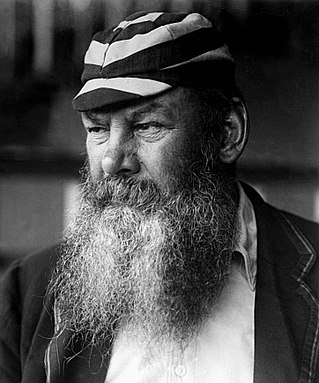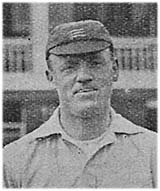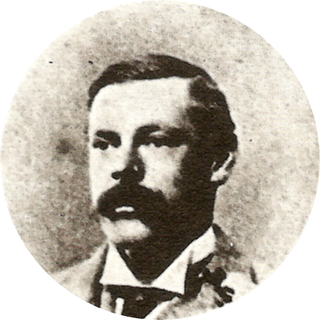Related Research Articles
Limited overs cricket, also known as one-day cricket or white ball cricket, is a version of the sport of cricket in which a match is generally completed in one day. There are a number of formats, including List A cricket, Twenty20 cricket, and 100-ball cricket. The name reflects the rule that in the match each team bowls a set maximum number of overs, usually between 20 and 50, although shorter and longer forms of limited overs cricket have been played.

William Gilbert Grace was an English amateur cricketer who was important in the development of the sport and is widely considered one of its greatest players. He was nominally amateur as a cricketer, but he is said to have made more money from his cricketing activities than any professional cricketer. He was an extremely competitive player and, although he was one of the most famous men in England, he was also one of the most controversial on account of his gamesmanship and moneymaking.

Hedley Verity was a professional cricketer who played for Yorkshire and England between 1930 and 1939. A slow left-arm orthodox bowler, he took 1,956 wickets in first-class cricket at an average of 14.90 and 144 wickets in 40 Tests at an average of 24.37.

Colonel George Robert Canning Harris, 4th Baron Harris,, generally known as Lord Harris, was a British colonial administrator and Governor of Bombay, best known for developing cricket administration via Marylebone Cricket Club (MCC).

Sir Pelham Francis Warner,, affectionately and better known as Plum Warner or "the Grand Old Man" of English cricket, was a Test cricketer and cricket administrator.

Norman Walter Dransfield Yardley was an English cricketer who played for Cambridge University, Yorkshire County Cricket Club and England, as a right-handed batsman and occasional bowler. An amateur, he captained Yorkshire from 1948 to 1955 and England on fourteen occasions between 1947 and 1950, winning four Tests, losing seven and drawing three. Yardley was named Wisden Cricketer of the Year in 1948, and in his obituary in Wisden Cricketers' Almanack he was described as Yorkshire's finest amateur since Stanley Jackson.

Somerset County Cricket Club is one of eighteen first-class county clubs within the domestic cricket structure of England and Wales. It represents the historic county of Somerset. Founded in 1875, Somerset was initially regarded as a minor county until official first-class status was acquired in 1895. Somerset has competed in the County Championship since 1891 and has subsequently played in every top-level domestic cricket competition in England. The club's limited overs team was formerly named the Somerset Sabres, but is now known only as Somerset.

Cambridge University Cricket Club, established in 1820, is the representative cricket club for students of the University of Cambridge. Depending on the circumstances of each individual match, the club has always been recognised as holding first-class status. The university played List A cricket in 1972 and 1974 only. It has not played top-level Twenty20 cricket.

Derbyshire County Cricket Club is one of eighteen first-class county clubs within the domestic cricket structure of England and Wales. It represents the historic county of Derbyshire. Its limited overs team is called the Derbyshire Falcons in reference to the famous peregrine falcon which nests on the Derby Cathedral. Founded in 1870, the club held first-class status from its first match in 1871 until 1887. Because of poor performances and lack of fixtures in some seasons, Derbyshire then lost its status for seven seasons until it was invited into the County Championship in 1895. Derbyshire is also classified as a List A team since the beginning of limited overs cricket in 1963; and classified as a senior Twenty20 team since 2003. In recent years the club has enjoyed record attendances with over 24,000 people watching their home Twenty20 fixtures in 2017 – a record for a single campaign. The local derby versus Yorkshire at Chesterfield now regularly sells out in advance.
Gentlemen v Players was a long-running series of cricket matches that began in July 1806 and was abolished in January 1963. It was a match between a team consisting of amateurs and a team consisting of professionals that reflected the English class structure of the 19th century. Typically, the professionals were working class people who earned their living by playing cricket, while the amateurs were middle- and upper-class products of the public school system, who were supposedly unpaid for playing. The professionals were paid wages by their county clubs and/or fees by match organisers, while the amateurs claimed expenses. However, while rules to distinguish amateurs from professionals were established by Marylebone Cricket Club (MCC), the system of allowable expenses was both controversial and complex, enabling some leading amateurs to be paid more than any professional for playing cricket.
Arthur Haygarth was a noted amateur cricketer who became one of cricket's most significant historians. He played first-class cricket for the Marylebone Cricket Club and Sussex between 1844 and 1861, as well as numerous other invitational and representative teams including an England XI and a pre-county Middlesex. A right-handed bat, Haygarth played 136 games now regarded as first-class, scoring 3,042 runs and taking 19 wickets with his part-time bowling. He was educated at Harrow, which had established a rich tradition as a proving ground for cricketers. He served on many MCC committees and was elected a life member in 1864.

Henry William "Harry" Lee was a professional English cricketer who played first-class cricket for the Marylebone Cricket Club (MCC) and Middlesex County Cricket Club between 1911 and 1934. He made one Test appearance for England, in 1931. An all-rounder, Lee was a right-handed batsman and bowled both off break and slow-medium pace bowling with his right arm. He scored 1,000 runs in a season on thirteen occasions. Part of the County Championship winning sides in 1920 and 1921, Lee aggregated 20,158 runs and took 401 wickets in first-class cricket.

Norman Stewart "Mandy" Mitchell-Innes was an amateur cricketer for Somerset, who played in one Test match for England in 1935. Between 1931 and 1949 Mitchell-Innes played 132 first-class matches, appearing 69 times for Somerset, and 43 times for Oxford University. In these matches he scored 6,944 runs, including 13 centuries and a top score of 207. He was well-regarded for the grace of his batting, but his cricket career was limited by both hay fever and his overseas work commitments.
Linden Park Cricket Club (LPCC) is a cricket club based at Higher Cricket Ground, Fir Tree Road, Royal Tunbridge Wells, Kent, England.

William Nichols Roe was an English first-class cricketer who played for Somerset County Cricket Club and Cambridge University in the late 19th century. A right-handed batsman who could play aggressively, but with a sound defensive method, Roe was considered one of Somerset's leading batsmen of the era. He played without merit for Cambridge, and only achieved his Blue during his final year at the university.
Cricket, and hence English amateur cricket, probably began in England during the medieval period but the earliest known reference concerns the game being played c.1550 by children on a plot of land at the Royal Grammar School, Guildford, Surrey. It is generally believed that cricket was originally a children's game as it is not until the beginning of the 17th century that reports can be found of adult participation.
Neil Thomas McCorkell was an English first-class cricketer. A successor as Hampshire wicket-keeper to George Brown, McCorkell made his debut in first-class cricket in 1932. He would play for Hampshire eitherside of the Second World War, with distinction as both a wicket-keeper and opening batsman. In 396 first-class matches, he scored over 16,000 runs and made 717 dismissals behind the stumps. He was Hampshire's most successful wicket-keeper until his records were surpassed by Bobby Parks. McCorkell never played Test cricket for England, largely due to the concurrent careers of the Kent wicket-keeping duo Les Ames and Godfrey Evans.
The Eton v Harrow cricket match is an annual match between public school rivals Eton College and Harrow School. It is one of the longest-running annual sporting fixtures in the world and is the last annual school cricket match still to be played at Lord's. In February 2022, the MCC announced that from 2023 onwards the fixture would no longer be held at the ground. It would be replaced by the finals of boys’ and girls’ schools competitions, as stated by MCC to be more inclusive. However, in September, 2022, following opposition from a section of its membership, the club decided that the match would be held at Lord's in 2023 to allow time for further consultation. In March, 2023 it was announced that the fixture would continue to be played at Lord's until at least 2027, following which there would be a review and a possible vote in 2028 on whether the match should remain at Lord's.

Benny Alexander Cameron Howell is an English first-class cricketer. Howell is a right-handed batsman who bowls right-arm medium-fast for Hampshire.
Henry Grierson was an English cricketer, barrister and author, who played cricket for Bedfordshire between 1909 and 1921 and for Cambridge University from 1911 to 1912.
References
- 1 2 Henry Grierson, "The History of the Forty Club", The Cricketer , 14 May 1960, pp. 140–41.
- ↑ "History of the Forty Club". The Forty Club. Retrieved 26 September 2019.